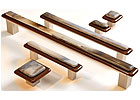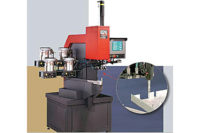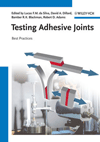
Grace White Glass uses Loctite 352 Adhesive to achieve reliable bonds and perfect cosmetics on these high-end drawer pulls and cabinet handles. Photo courtesy Roger Chase
The company had been experiencing problems with the epoxy adhesive it was using for the bond. Curing performance was inconsistent, and handles occasionally came apart in use. Assemblers also found the epoxy adhesive difficult to dispense neatly and consistently, resulting in cosmetic flaws that were unacceptable in a high-end custom product.
Grace White decided to try a modified acrylic adhesive made by Henkel called Loctite 352, which is optically clear when cured. The adhesive’s glass-like transparency makes the glue line between parts imperceptible, improving product cosmetics and reducing scrap. In addition, Loctite 352 cures faster than the epoxy it replaced, permitting parts to be handled sooner.
This adhesive can be cured with ultraviolet light or with a chemical activator. However, light-curing was not feasible in this application because many of the glass parts are dark or opaque, so the activator-cured option was chosen. After consultation with Henkel, Grace White Glass selected Loctite 7387 Depend Activator.
Following assembly of the metal parts, the activator is applied by brush to the mating surfaces of the glass and metal components, and allowed to flash off. The adhesive is then applied to the aluminum substrate, and the parts are mated and allowed to cure for 24 hours.
“Bond failures have been eliminated and our return rates have declined dramatically,” says company president Ann Ivory. She also says that the acrylic adhesive completely fills voids and irregularities in substrate surfaces, promoting more reliable bonds.
Grace White also began using Loctite 290 Threadlocker to secure the zinc-plated screws with which the aluminum components are assembled prior to the glass being bonded. Assemblers screw the metal parts together, and then apply a drop of 290 Threadlocker to the subassembly.
Because of the threadlocker’s low viscosity and high capillary action, it wicks between the engaged threads of the assembled parts. This self-wicking nature allows Loctite 290 to be applied post-assembly, enabling workers to assemble metal components dry. Ivory says using Loctite 290 has not only improved the ease and speed of assembly, it has made them trouble-free.
For more information on adhesives and threadlockers, call 860-571-5100 or visit www.loctite.com.





